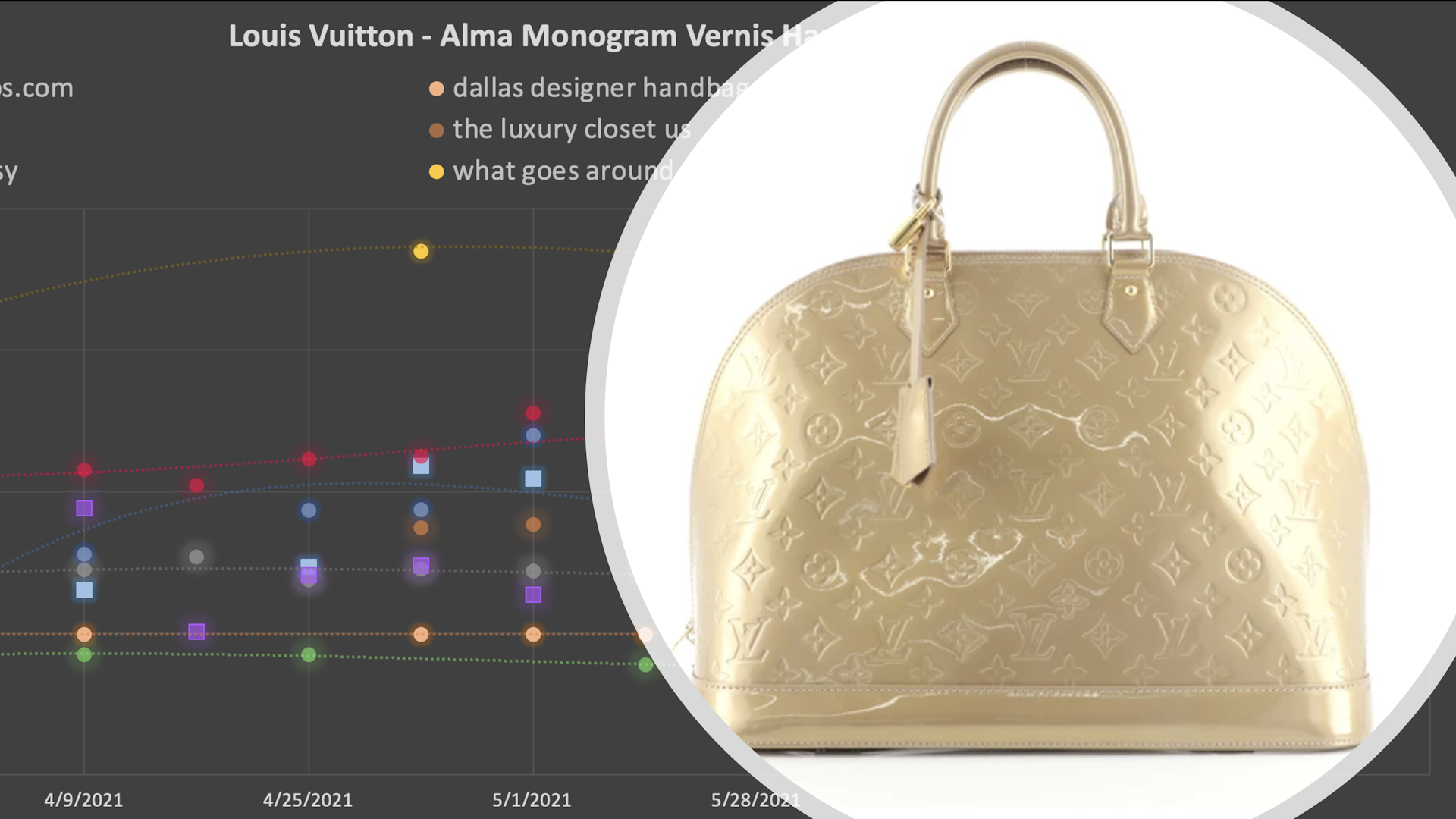
Introduction
Today’s post outlines the evolution of the Alma resale values over the past two months. A resale value is the price at which a retailer or a peer sells a pre-owned item on second-hand marketplaces. From the resale values, we can compute the fair market value and populate instant offers for the retailers using the Resell Interface with instant quotes. To prepare this study, we collected data over Google Shopping, managed marketplaces (such as TheRealReal and Rebag) and peer-to-peer marketplaces (such as Tradesy and Poshmark).
First, a bit of background about this model. Louis Vuitton designed the Alma handbag getting inspiration from the Art Deco original, introduced in 1934. This model is available in different styles, sizes and a wide array of colors. For our first data visualization post, we will focus on the Alma Monogram Vernis. As the resale values and the fair market value depend on the size of the handbag, we will study this model based on its size.
- BB: 10″W x 8″H x 5″D
- PM: 13″W x 10″H x 6″D
- MM: 14″W x 11″H x 7″D
- GM: 15″W x 12″H x 8″D
- XL: 18"W x 13"H x 9"D

Are you ready to dive into some data? No worries, we are taking it easy for our first case study.
Data exploration
Let’s look at the data dispersion (i.e. the spread of the data from the lowest to the highest value)!
The following graphs show the weekly resale values in blue and the average resale values in yellow. In this study, we only use arithmetic averages. It means that each data point contributes equally to the final average.
Resale values over time
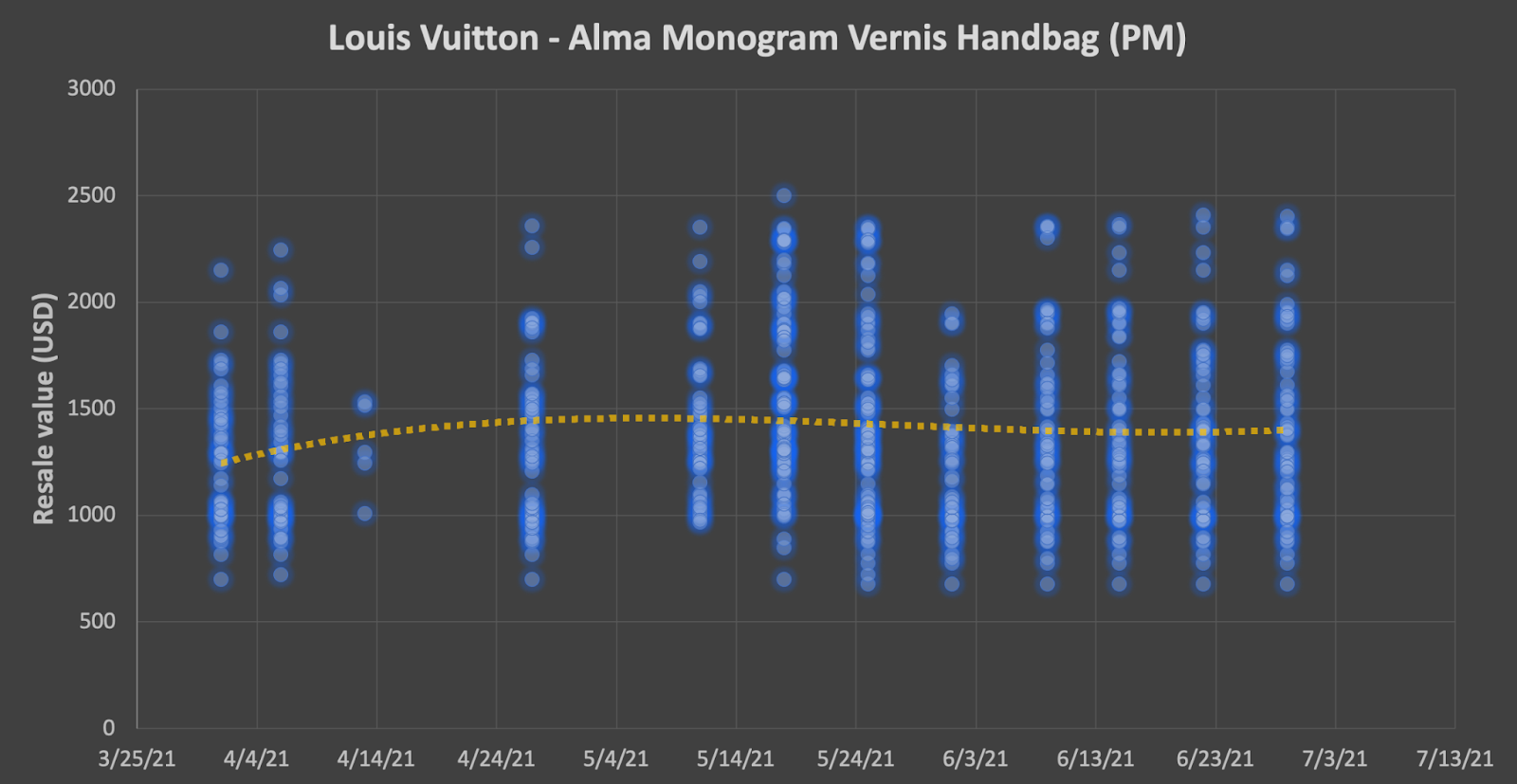 The resale values go as low as $675 and reach a maximum of $2500. Over time, the fair market value of this model in size PM is about $1400 going from a low $1310 in April to a high $1490 in May (all pre-owned conditions considered).
The resale values go as low as $675 and reach a maximum of $2500. Over time, the fair market value of this model in size PM is about $1400 going from a low $1310 in April to a high $1490 in May (all pre-owned conditions considered).
Here, each data point corresponds to the price of a pre-owned item:
- It can be in different conditions evaluated based on the sign of wears: excellent, great, good, fair
- It can be listed by different retailers or peers.
This explains why there is such a wide range in pricing. When we compute the fair market value, we generally compute them by condition. It means for a unique item (for example, Alma Monogram Vernis PM), we have four market values.
Also, what you can see is only a subset of the data we collect each week for the Louis Vuitton Alma Monogram Vernis. In reality, we collect prices from more vendors and instead of an arithmetic average, we use weighted arithmetic average. We compute a fair market value by weighing each data point depending on their coherence with past price trends, the popularity, and reliability of the vendor. For example, large managed marketplaces have generally more weight than smaller or peer-to-peer marketplaces. To make it simpler, we decided to explore this in a later data visualization post!
Let’s take a look at the other sizes:
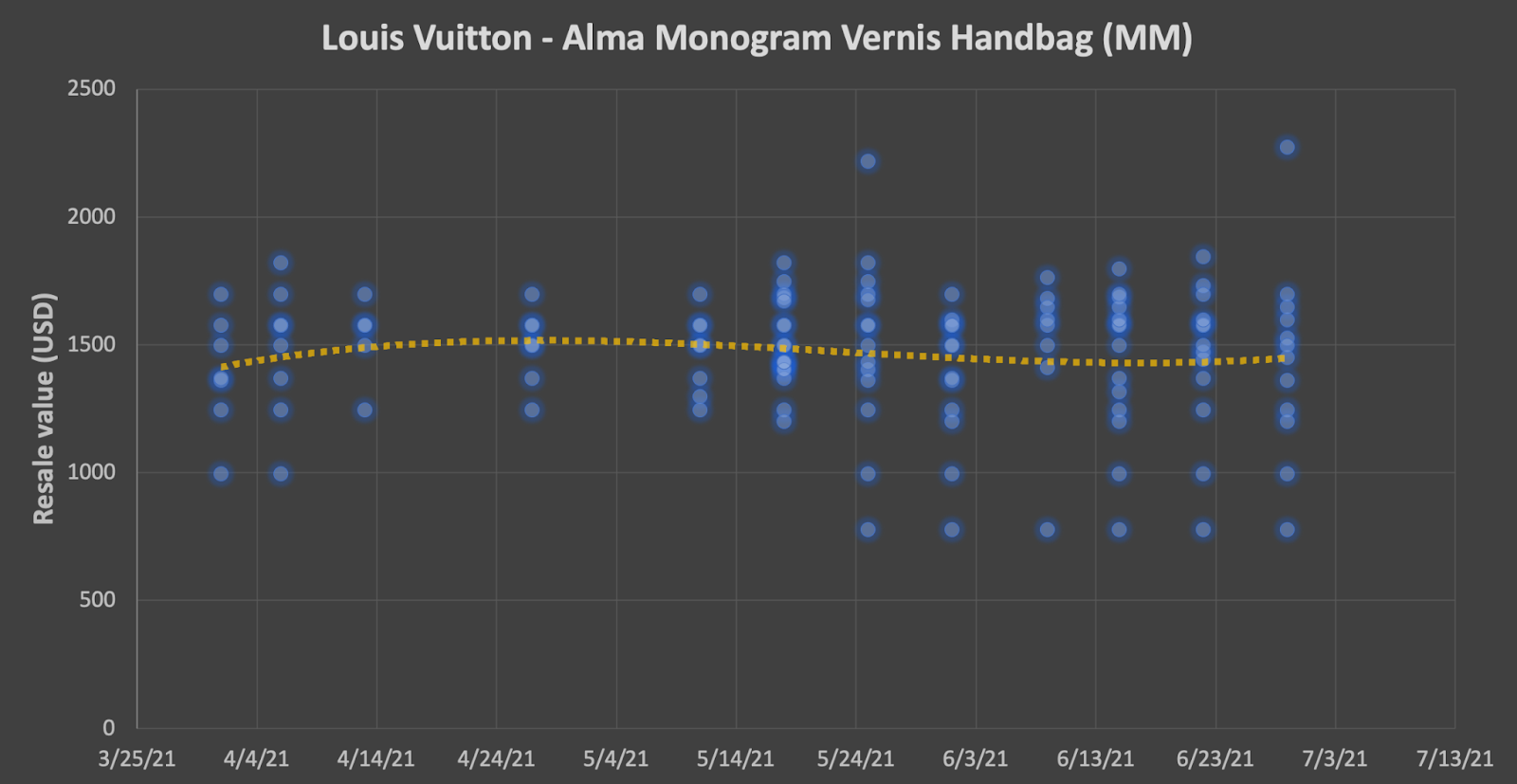 The resale values go as low as $775 and reach a maximum of $2270. Over time, the fair market value of this model in size MM is about $1460 going from a low $1430 in June to a high $1500 in May (all pre-owned conditions considered). Overall, the fair market value of the Alma Monogram Vernis MM has been pretty steady over the last two months.
The resale values go as low as $775 and reach a maximum of $2270. Over time, the fair market value of this model in size MM is about $1460 going from a low $1430 in June to a high $1500 in May (all pre-owned conditions considered). Overall, the fair market value of the Alma Monogram Vernis MM has been pretty steady over the last two months.
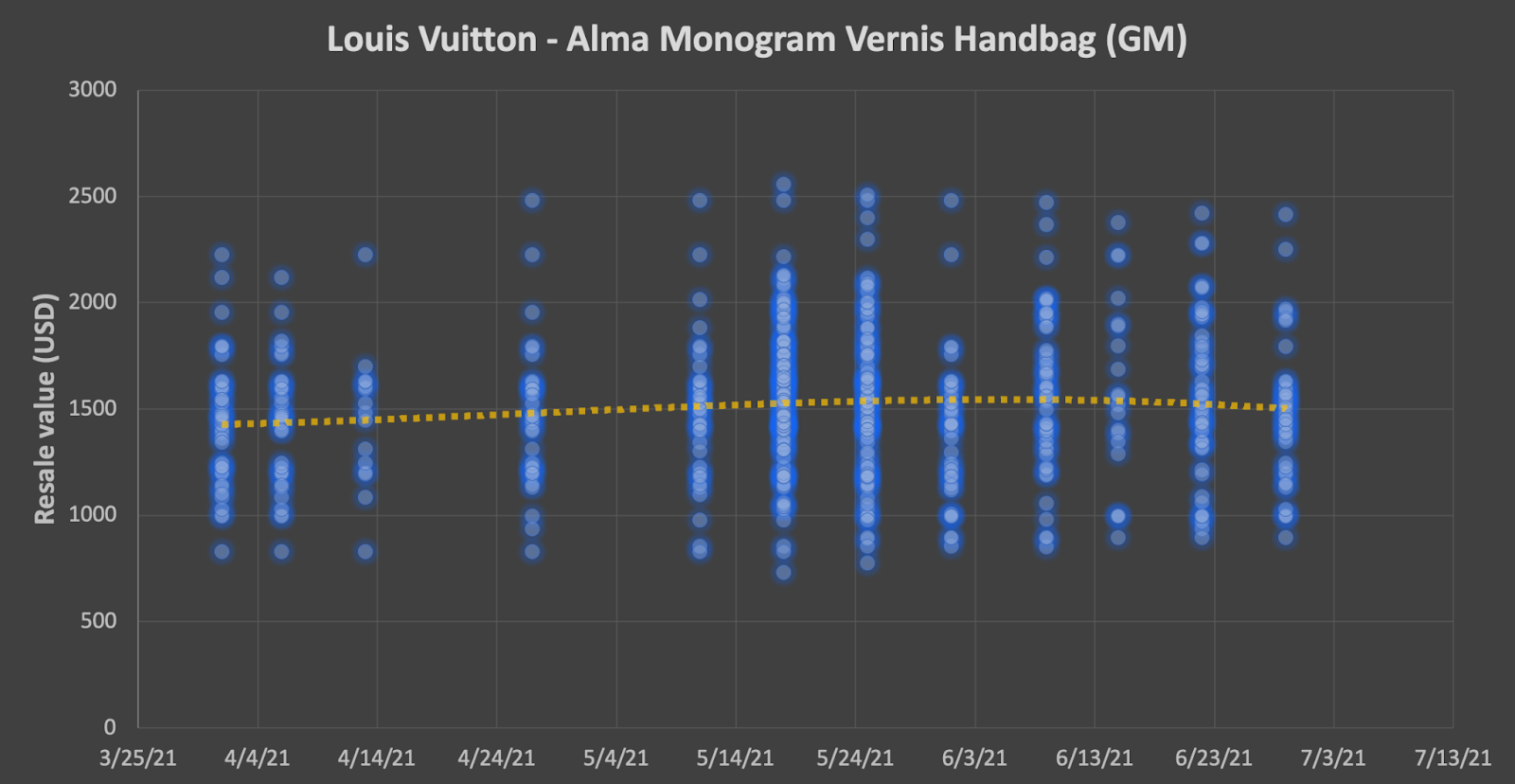 The resale values go as low as $730 and reach a maximum of $2550. Over time, the fair market value of this model in size GM is about $1510 going from a low $1440 in April to a high $1550 in May (all pre-owned conditions considered). Overall, the fair market value of the Alma Monogram Vernis GM has slightly increased over the last two months.
The resale values go as low as $730 and reach a maximum of $2550. Over time, the fair market value of this model in size GM is about $1510 going from a low $1440 in April to a high $1550 in May (all pre-owned conditions considered). Overall, the fair market value of the Alma Monogram Vernis GM has slightly increased over the last two months.
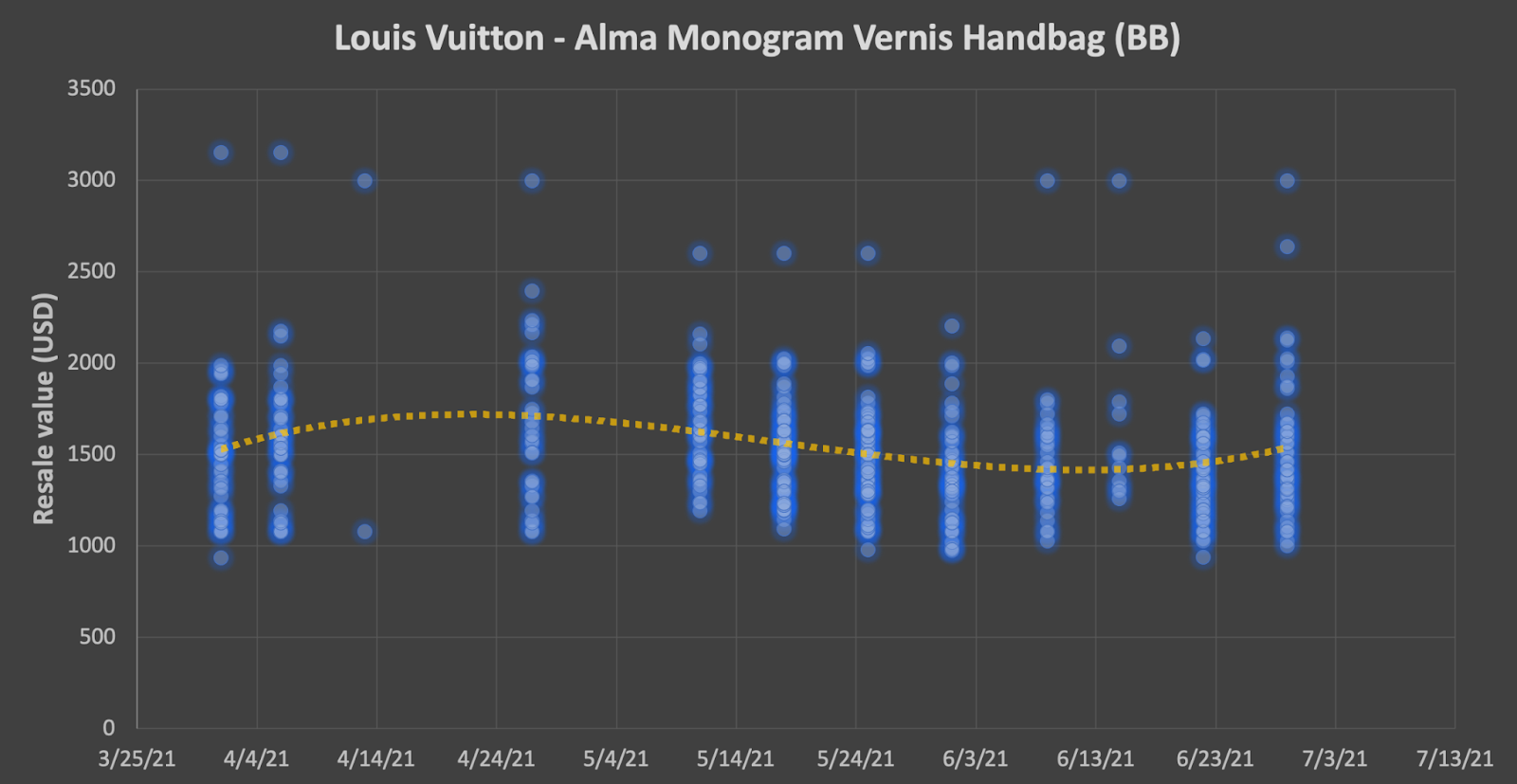 The resale values go as low as $930 and reach a maximum of $3150. Over time, the fair market value of this model in size BB is about $1540 going from a low $1460 in June to a high $1600 in June (all pre-owned conditions considered). For some models, small sizes might be rare but popular and which translates into a higher fair market value compared to the other sizes.
The resale values go as low as $930 and reach a maximum of $3150. Over time, the fair market value of this model in size BB is about $1540 going from a low $1460 in June to a high $1600 in June (all pre-owned conditions considered). For some models, small sizes might be rare but popular and which translates into a higher fair market value compared to the other sizes.
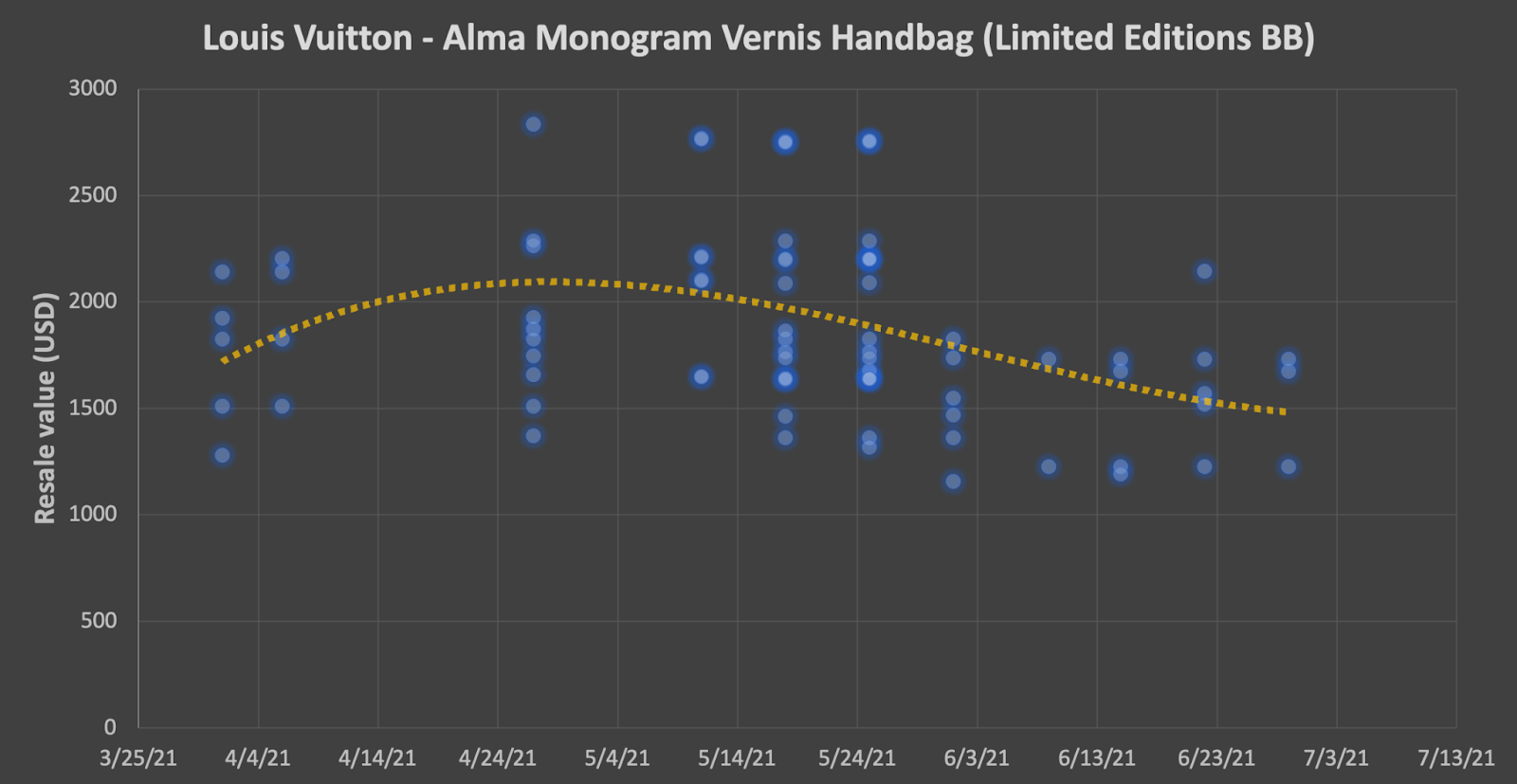 The resale values go as low as $1155 and reach a maximum of $1835. Over time, the fair market value of this model in size BB Limited Editions is about $1870 going from a low $1530 in April to a high $2025 in May (all pre-owned conditions considered). We generally collect less data for limited edition models but they usually resell for higher prices. This graph includes different limited editions, that is why there is great data variability over time. We usually distinguish limited editions.
The resale values go as low as $1155 and reach a maximum of $1835. Over time, the fair market value of this model in size BB Limited Editions is about $1870 going from a low $1530 in April to a high $2025 in May (all pre-owned conditions considered). We generally collect less data for limited edition models but they usually resell for higher prices. This graph includes different limited editions, that is why there is great data variability over time. We usually distinguish limited editions.
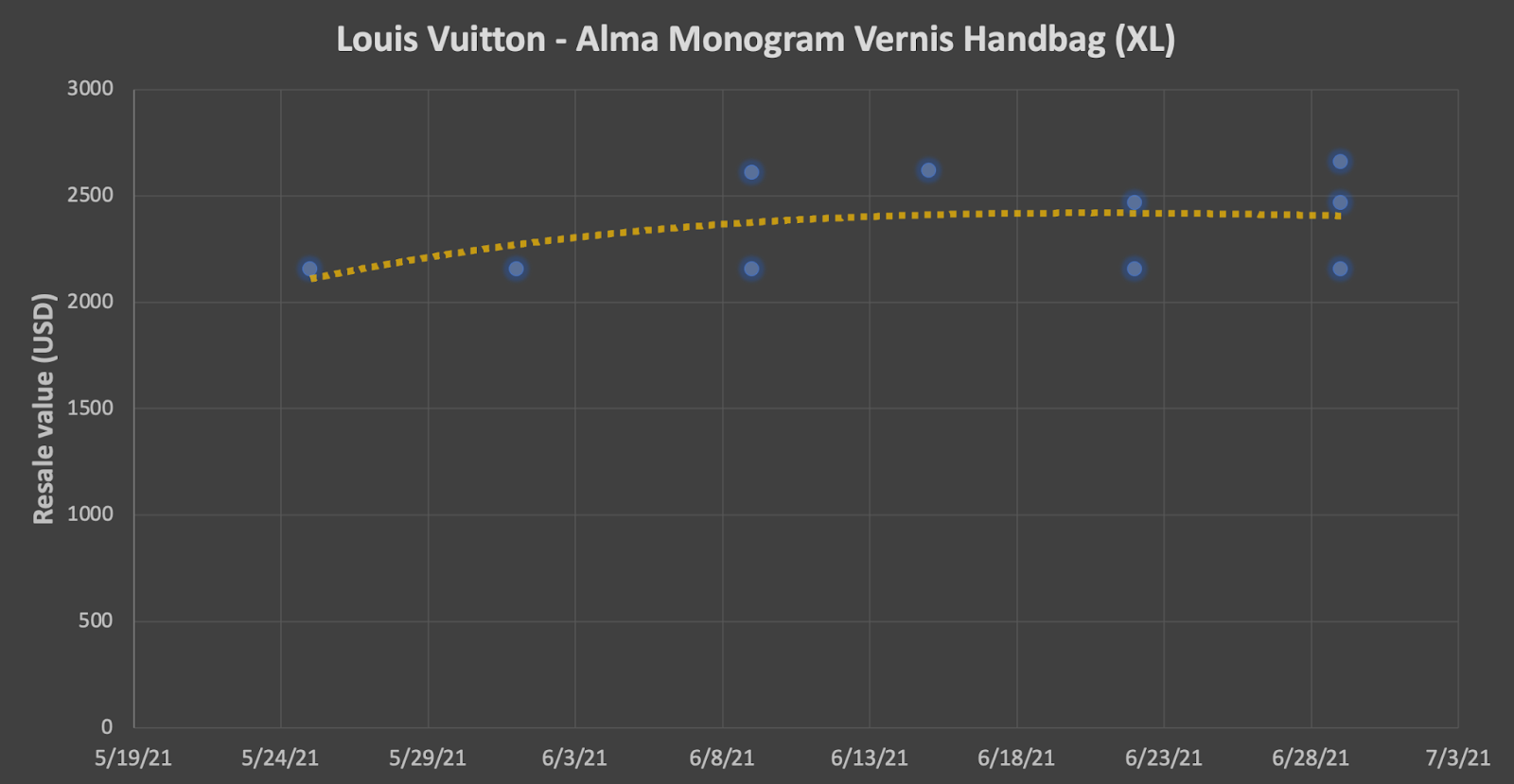 The Alma Monogram Vernis XL Handbag is also rare and has an average fair market value higher than other models. Here, we won’t compute a fair market value since we do not have enough data points. As soon as we collect more data and can detect price trends, we will be able to give a fair market value for this model!
The Alma Monogram Vernis XL Handbag is also rare and has an average fair market value higher than other models. Here, we won’t compute a fair market value since we do not have enough data points. As soon as we collect more data and can detect price trends, we will be able to give a fair market value for this model!
If we sum up the fair market values computed over all conditions, it gives:
- BB: $1540
- PM: $1400
- MM: $1460
- GM: $1510
- XL: not enough data
As you might notice, the fair market value doesn’t always increase with the size of the handbag nor is it linear. Which makes it difficult for retailers and peers to understand and estimate fair market values manually.
Also, why are there such wide ranges of resale values in the data?
Well, each vendor prices items differently. That’s why - again - it can make it difficult to estimate the fair market value of an item. Retailers and peers must make sure to visit different websites and collect enough data points so they can have an accurate idea of the current fair market value of a handbag. With our algorithms, we collect and filter hundreds to thousands of data points for a unique model each week. With this data, we can evaluate the evolution of the average resale value and estimate fair market values.
And we do so for thousands of handbags!
Resale value evolution by vendor
Let’s look at the difference in pricing between vendors for the sizes PM, MM, and GM of the Alma Monogram Vernis handbag.
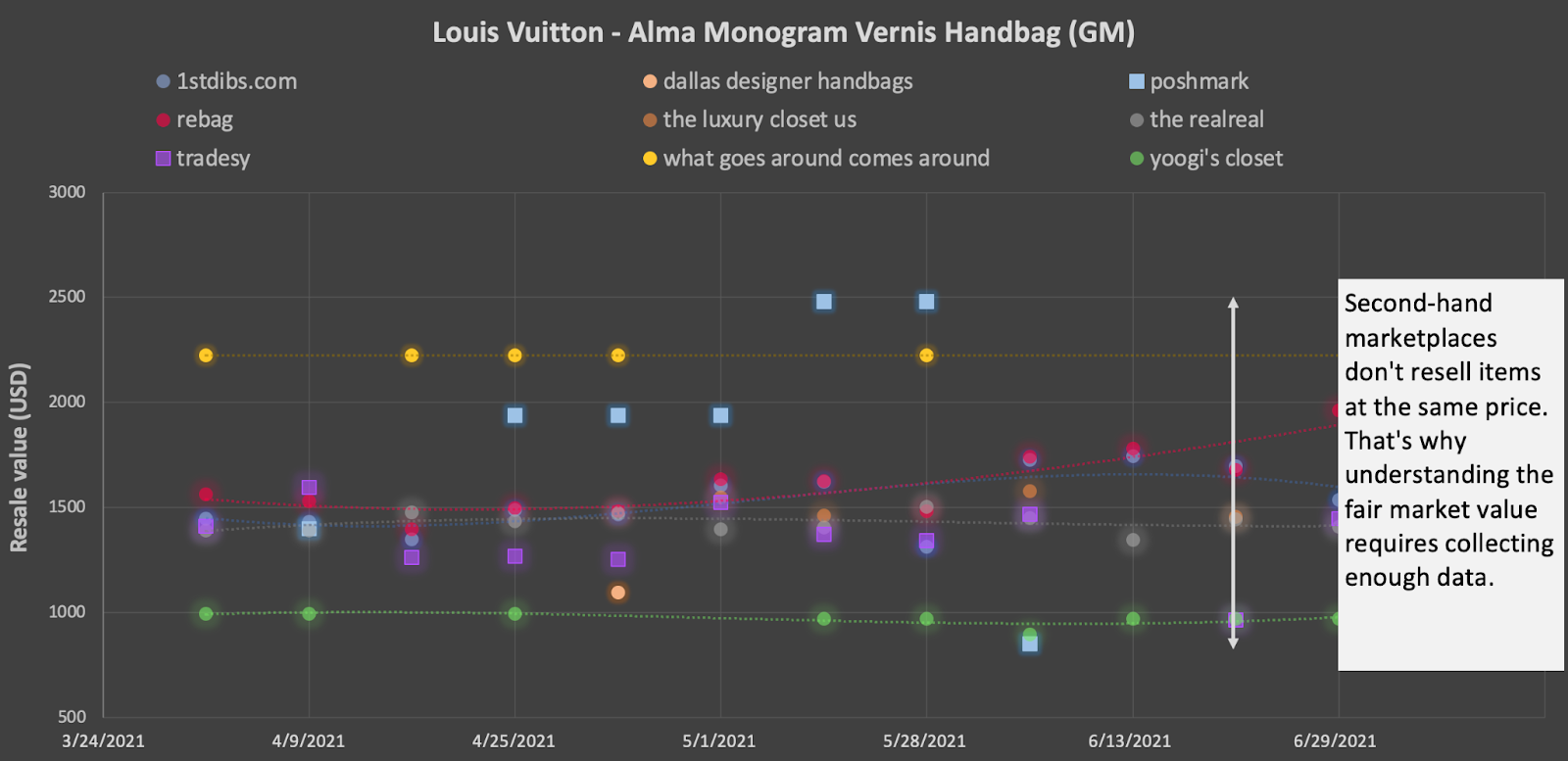
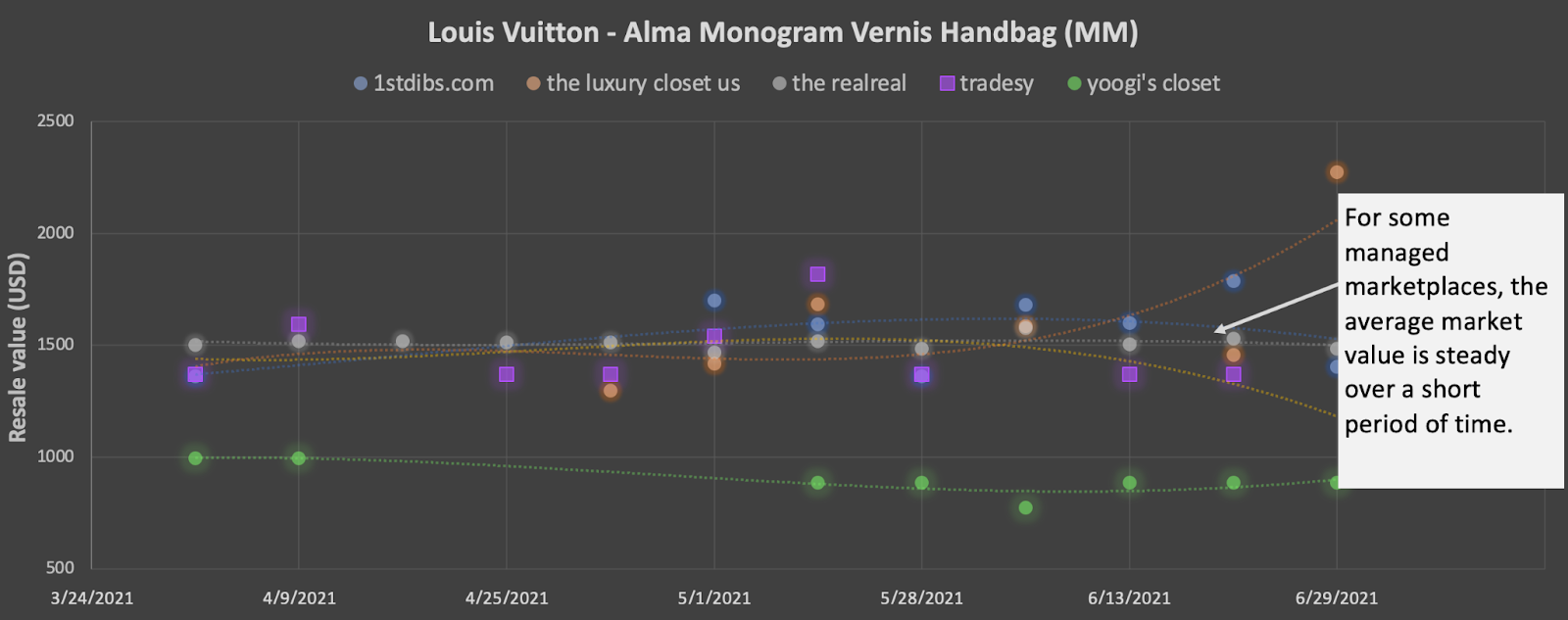
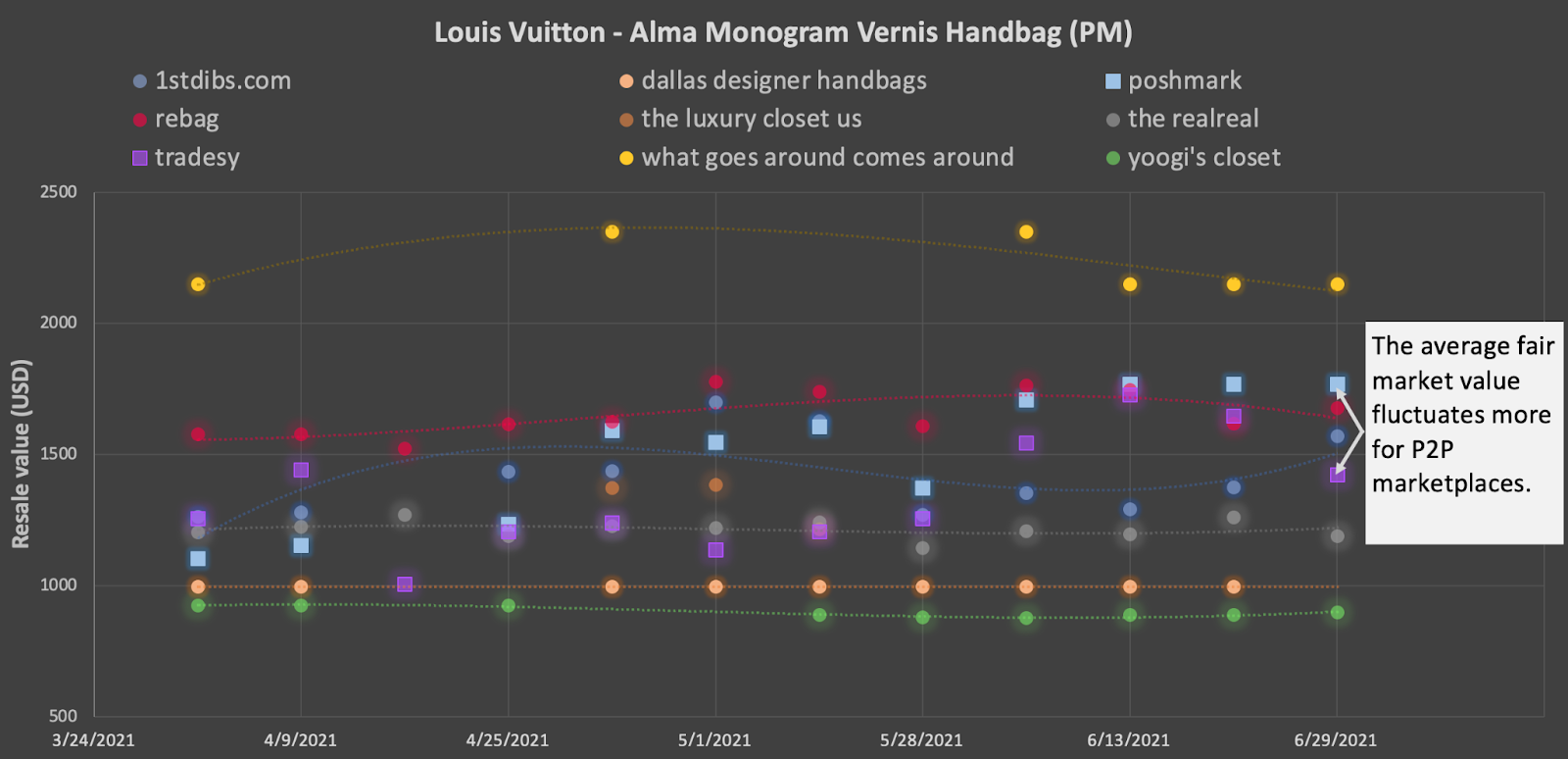
These are nice colorful graphs, don’t you agree? Well, it’s not the only takeaway:
- Second-hand marketplaces don't resell items at the same price. That's why understanding the fair market value requires collecting enough data.
- On one hand, for some managed marketplaces, the average market value is steady over a short period of time.
- On the other hand, the average fair market value fluctuates more for P2P marketplaces.
Conclusion
We hope you’ve enjoyed this exploration of pricing data for the Louis Vuitton Alma Monogram Vernis Handbag. We can see that the price might change over a short period of time and varies depending on the vendor. We know that some data points are more reliable than others, depending on their coherence with historical trends, the vendor and other parameters such as the quality of the additional information we collect (titles, description, condition, etc.). Our algorithms are made to give more importance to popular vendors and reliable points and compute fair market values depending on the conditions: excellent, great, good, fair. At Trendful we offer different plans to access our price database, check them out here!
Stay tuned for other data visualization posts!
If you want to know more about how we compute fair market values, read our guide here. And if you are confused with some of the terms, don’t hesitate to check our glossary.